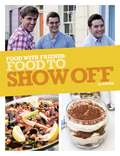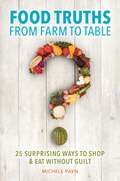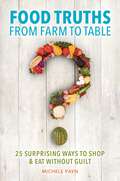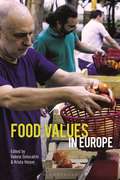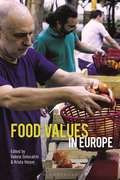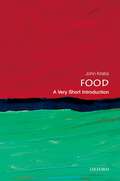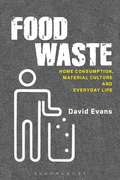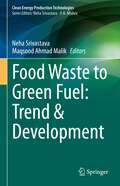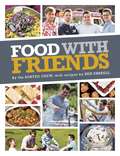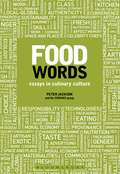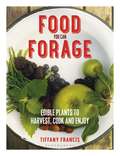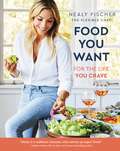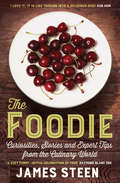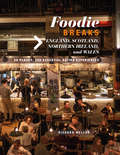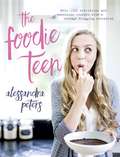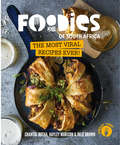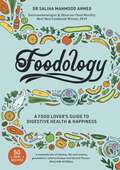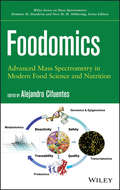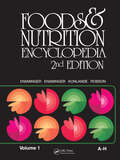- Table View
- List View
Food to Show Off
by The Sorted Crew Ben EbbrellFood to Show Off is the fourth chapter from The Sorted Crew's new cookbook, Food with Friends.If you've been bragging about your killer cooking skills for years, this chapter will help you to put your money where your mouth is! Not only have we got some fancysounding dishes for starters, mains and desserts, we've also gone to the effort of creating different menus for you, with courses that complement each other perfectly. Recipes include: Goat's Cheese and Black Pepper Mousse, Blueberry Duck with Potato Rosti, Tapanade Beef Wellington and Chocolate and Hazelnut Torte.Food with Friends is the second cookbook from The Sorted Crew, with recipes by Ben Ebbrell. It's the ultimate guide for entertaining friends in a fun and fuss-free way, from romantic suppers and family barbecues to curry nights for hungry hordes. Whether you're cooking for two or twenty, Food with Friends by The Sorted Crew is THE book for easy entertaining.The Sorted Crew came together in their university holidays, sharing their cooking highs and lows with each other in the pub. Headed up by Ben Ebbrell and Barry Taylor, this original group of 8 mates with an interest in food has now grown into a highly engaged online community of hundreds of thousands, that works together to get food challenges sorted. The SortedFood video recipes on YouTube now get millions of views every month. They self-published two recipe books, A Recipe for Student Survival and A Rookie's Guide to Crackin' Cooking, and Beginners... Get Sorted was their first book with Penguin.
Food Truths from Farm to Table: 25 Surprising Ways to Shop & Eat without Guilt
by Michele PaynDon't believe everything you're told about food—most of it is highly misleading or completely untrue. Written by a farm and food advocate, this book identifies marketing half-truths and guides you through the aisles of the grocery store to simplify smart food shopping and restore your freedom to enjoy food.What is the only "food" on your dinner table that does not contain hormones? How can animals raised for food also be treated with respect? Is it true that a typical serving of broccoli has more estrogen than a serving of steak? Why is more than 40 percent of food wasted in the United States? Food Truths from Farm to Table: 25 Surprising Ways to Shop & Eat without Guilt answers all of these questions and many more, bringing an unheard voice into the highly emotional food debate. Authored by Michele Payn, a leading farm and food advocate with an in-depth understanding of both sides of the plate, this intriguing book helps readers understand how food is really produced, answers food critics, and points out how food marketing and labels are often half-truths or even "less-than-half truths." These 25 food truths enable an understanding of how food is grown, providing a transparent window into today's farming and ranching practices that empowers you to make informed personal choices and determine what is right for your family. Each chapter presents a farm or ranch story, answers questions around a major issue, provides science-based information, and includes a sidebar section of food truths and myths.Readers will gain insights from a food expert who offers a viewpoint that stands in stark contrast to the typical sensationalist and often negative perspective on fashionable food—accurate information that will help you to better trust the intentions and processes in farming and ranching. The revelations in this book will simplify food shopping, reduce guilt about being a consumer, and give you the freedom to enjoy your food again.
Food Truths from Farm to Table: 25 Surprising Ways to Shop & Eat without Guilt
by Michele PaynDon't believe everything you're told about food—most of it is highly misleading or completely untrue. Written by a farm and food advocate, this book identifies marketing half-truths and guides you through the aisles of the grocery store to simplify smart food shopping and restore your freedom to enjoy food.What is the only "food" on your dinner table that does not contain hormones? How can animals raised for food also be treated with respect? Is it true that a typical serving of broccoli has more estrogen than a serving of steak? Why is more than 40 percent of food wasted in the United States? Food Truths from Farm to Table: 25 Surprising Ways to Shop & Eat without Guilt answers all of these questions and many more, bringing an unheard voice into the highly emotional food debate. Authored by Michele Payn, a leading farm and food advocate with an in-depth understanding of both sides of the plate, this intriguing book helps readers understand how food is really produced, answers food critics, and points out how food marketing and labels are often half-truths or even "less-than-half truths." These 25 food truths enable an understanding of how food is grown, providing a transparent window into today's farming and ranching practices that empowers you to make informed personal choices and determine what is right for your family. Each chapter presents a farm or ranch story, answers questions around a major issue, provides science-based information, and includes a sidebar section of food truths and myths.Readers will gain insights from a food expert who offers a viewpoint that stands in stark contrast to the typical sensationalist and often negative perspective on fashionable food—accurate information that will help you to better trust the intentions and processes in farming and ranching. The revelations in this book will simplify food shopping, reduce guilt about being a consumer, and give you the freedom to enjoy your food again.
Food Values in Europe
by Valeria Siniscalchi Krista HarperWhat can a focus on “food projects” in Europe tell us about contemporary social processes and cultural debates? Valeria Siniscalchi and Krista Harper show how food becomes a marker of identity and resistance to social exclusion, and how food values become tools for transforming power dynamics at the local level and beyond. Through the comparison of food-centered movements across Europe, the book explains how these forms of mobilization express ideologies as well as economic and political objectives.The chapters use an ethnographic approach to focus on the transformation of values carried by individuals and groups in relation to food in Portugal, Greece, Latvia, Moldova, Denmark, the UK, Italy, and France. Contributors analyze food values, as expressed in daily life and livelihoods, through specific practices of production, exchange, and consumption. Topics covered include Prague's urban agricultural scene, the perception of poverty in Moldova, shepherds' protests in Sardinia, and organic food cooperatives in Catalonia.
Food Values in Europe
by Valeria Siniscalchi Krista HarperWhat can a focus on “food projects” in Europe tell us about contemporary social processes and cultural debates? Valeria Siniscalchi and Krista Harper show how food becomes a marker of identity and resistance to social exclusion, and how food values become tools for transforming power dynamics at the local level and beyond. Through the comparison of food-centered movements across Europe, the book explains how these forms of mobilization express ideologies as well as economic and political objectives.The chapters use an ethnographic approach to focus on the transformation of values carried by individuals and groups in relation to food in Portugal, Greece, Latvia, Moldova, Denmark, the UK, Italy, and France. Contributors analyze food values, as expressed in daily life and livelihoods, through specific practices of production, exchange, and consumption. Topics covered include Prague's urban agricultural scene, the perception of poverty in Moldova, shepherds' protests in Sardinia, and organic food cooperatives in Catalonia.
Food: A Very Short Introduction (Very Short Introductions Ser.)
by John KrebsIn this Very Short Introduction, Prof Lord John Krebs provides a brief history of human food, from our remote ancestors 3 million years ago to the present day. By looking at the four great transitions in human food - cooking, agriculture, processing, and preservation - he considers a variety of questions, including why people like some kinds of foods and not others; how your senses contribute to flavour; the role of genetics in our likes and dislikes; and the differences in learning and culture around the world. In turn he considers aspects of diet, nutrition, and health, and the disparity between malnutrition in some places and overconsumption in others. Finally, he considers some of the big issues - the obesity crisis, sustainable agriculture, the role of new technologies such as genetic modification of crops, and ends by posing the question: how will it be possible to feed a population of 9 billion in 2050, without destroying our natural environment? ABOUT THE SERIES: The Very Short Introductions series from Oxford University Press contains hundreds of titles in almost every subject area. These pocket-sized books are the perfect way to get ahead in a new subject quickly. Our expert authors combine facts, analysis, perspective, new ideas, and enthusiasm to make interesting and challenging topics highly readable.
Food Waste: Home Consumption, Material Culture and Everyday Life (Materializing Culture)
by David EvansIn recent years, food waste has risen to the top of the political and public agenda, yet until now there has been no scholarly analysis applied to the topic as a complement and counter-balance to campaigning and activist approaches. Using ethnographic material to explore global issues, Food Waste unearths the processes that lie behind the volume of food currently wasted by households and consumers. The author demonstrates how waste arises as a consequence of households negotiating the complex and contradictory demands of everyday life, explores the reasons why surplus food ends up in the bin, and considers innovative solutions to the problem.Drawing inspiration from studies of consumption and material culture alongside social science perspectives on everyday life and the home, this lively yet scholarly book is ideal for students and researchers from a wide range of disciplines, along with anyone interested in understanding the food that we waste.
Food Waste: Home Consumption, Material Culture and Everyday Life (Materializing Culture)
by David M. EvansIn recent years, food waste has risen to the top of the political and public agenda, yet until now there has been no scholarly analysis applied to the topic as a complement and counter-balance to campaigning and activist approaches. Using ethnographic material to explore global issues, Food Waste unearths the processes that lie behind the volume of food currently wasted by households and consumers. The author demonstrates how waste arises as a consequence of households negotiating the complex and contradictory demands of everyday life, explores the reasons why surplus food ends up in the bin, and considers innovative solutions to the problem.Drawing inspiration from studies of consumption and material culture alongside social science perspectives on everyday life and the home, this lively yet scholarly book is ideal for students and researchers from a wide range of disciplines, along with anyone interested in understanding the food that we waste.
Food Waste to Green Fuel: Trend & Development (Clean Energy Production Technologies)
by Neha Srivastava Maqsood Ahmad MalikThis edited book covers all the existing possibilities of using food waste as a potential, alternative and ‘ready to use’, feed stock for biofuels production. Moreover, it also presents all the sustainable and economically feasible biofuels option with their details strategies, mechanism, advantages, draw backs and future scope. It also explores in depth knowledge of food waste, and details the processing as well as opportunities to utilize it at for mass scale biofuels production. The practical feasibility and economic sustainability of biofuels production is still suffering with its cost intensity and lack of rigorous scientific strategies as well as inputs to explore it on further at upscale level. Low cost, carbon rich, economic and environmental friendly feedstock, may have strong possibilities to reduce the overall biofuels production cost and the book is based on this strategy. The book is of interest to academicians and researchers interested in industries related to biofuels production, food processing industries and industries related to waste valorization.
Food with Friends
by The Sorted Crew Ben EbbrellEnjoy Food with Friends from the Sorted Crew.Food with Friends is the second cookbook from The Sorted Crew, with recipes by Ben Ebbrell. It's the ultimate guide for entertaining friends in a fun and fuss-free way, from romantic suppers and family barbecues to curry nights for hungry hordes. Whether you're cooking for two or twenty, Food with Friends by The Sorted Crew is THE book for easy entertaining.The Sorted Crew came together in their university holidays, sharing their cooking highs and lows with each other in the pub. Headed up by Ben Ebbrell and Barry Taylor, this original group of 8 mates with an interest in food has now grown into a highly engaged online community of hundreds of thousands, that works together to get food challenges sorted. The SortedFood video recipes on YouTube now get millions of views every month. They self-published two recipe books, A Recipe for Student Survival and A Rookie's Guide to Crackin' Cooking, and Beginners... Get Sorted was their first book with Penguin.
Food Words: Essays in Culinary Culture
by Peter JacksonFood Words is a series of provocative essays on some of the most important keywords in the emergent field of food studies, focusing on current controversies and on-going debates.Words like 'choice' and 'convenience' are often used as explanatory terms in understanding consumer behavior but are clearly ideological in the way they reflect particular positions and serve specific interests, while words like 'taste' and 'value' are no less complex and contested.Inspired by Raymond Williams, Food Words traces the multiple meanings of each of our keywords, tracking nuances in different (academic, commercial and policy) contexts. Mapping the dynamic meanings of each term, the book moves forward from critical assessment to active intervention -- an attitude that is reflected in the lively, sometimes combative, style of the essays. Each essay is research-based and fully referenced but accessible to the general reader.With a foreword by eminent food scholar Warren Belasco, Professor of American Studies at the University of Maryland-Baltmore County, and written by an inter-disciplinary team associated with the CONANX research project (Consumer culture in an 'age of anxiety'), Food Words will be essential reading for food scholars across the arts, humanities and social sciences.
Food Words: Essays in Culinary Culture
by Peter JacksonFood Words is a series of provocative essays on some of the most important keywords in the emergent field of food studies, focusing on current controversies and on-going debates.Words like 'choice' and 'convenience' are often used as explanatory terms in understanding consumer behavior but are clearly ideological in the way they reflect particular positions and serve specific interests, while words like 'taste' and 'value' are no less complex and contested.Inspired by Raymond Williams, Food Words traces the multiple meanings of each of our keywords, tracking nuances in different (academic, commercial and policy) contexts. Mapping the dynamic meanings of each term, the book moves forward from critical assessment to active intervention -- an attitude that is reflected in the lively, sometimes combative, style of the essays. Each essay is research-based and fully referenced but accessible to the general reader.With a foreword by eminent food scholar Warren Belasco, Professor of American Studies at the University of Maryland-Baltmore County, and written by an inter-disciplinary team associated with the CONANX research project (Consumer culture in an 'age of anxiety'), Food Words will be essential reading for food scholars across the arts, humanities and social sciences.
Food You Can Forage: Edible Plants to Harvest, Cook and Enjoy
by Ms Tiffany FrancisWhen you know where to look, each season Nature provides a generous spread of tasty treats ripe for the picking. Foraging can be an adventure for the entire family, and Food You Can Forage is packed with photos, illustrations and useful information to help you identify and find food in the wild, as well as delicious recipes to try with your finds.In this book, Tiffany Francis explores a range of habitats, revealing why plants grow where they do and which other living things live there too. Tiffany offers tips to help make the most of time spent outdoors wherever you are, and her delightful text also explains everything from the birds to look out for along the coast to which bumblebees you're most likely to spot on your local heathland.Whether you prefer to avoid eating overly processed foods or just enjoy spending time outdoors with your family, knowing how to ethically source food for free in the wild is a valuable and fun skill that anyone can learn.
Food You Can Forage: Edible Plants to Harvest, Cook and Enjoy
by Tiffany FrancisWhen you know where to look, each season Nature provides a generous spread of tasty treats ripe for the picking. Foraging can be an adventure for the entire family, and Food You Can Forage is packed with photos, illustrations and useful information to help you identify and find food in the wild, as well as delicious recipes to try with your finds.In this book, Tiffany Francis explores a range of habitats, revealing why plants grow where they do and which other living things live there too. Tiffany offers tips to help make the most of time spent outdoors wherever you are, and her delightful text also explains everything from the birds to look out for along the coast to which bumblebees you're most likely to spot on your local heathland.Whether you prefer to avoid eating overly processed foods or just enjoy spending time outdoors with your family, knowing how to ethically source food for free in the wild is a valuable and fun skill that anyone can learn.
Food You Want: For the Life You Crave
by Nealy FischerA "wellness visionary who serves up super-food!" (Mark Hyman, MD) shares her tips, secrets, and +100 gluten-free recipes for living a healthy, flexible life--in the kitchen and out.Whether you're a parent feeding family of 6 or cooking for 1 or 2, you're probably busy--really busy--juggling all of life's obligations. And you probably just want to sit down for a meal of food you truly want--craveable, healthy food that makes you feel as good as it tastes. With more than 100 clean, fresh, gluten-free recipes, Food You Want helps you create healthy, energizing dishes, all while saving time and banishing meal prep stress. With Nealy's Flexible Flips, you can mix, match, and substitute ingredients. Some Flips health-ify recipes (pizza quiche that tastes just like a real slice of pizza); other Flips transform taste, showing you that healthy can always equal delicious. Have a Flop? No worries--there are Flips for those too. With Nealy's flexible, adaptable system you'll have a simpler recipe for success, both in and out of the kitchen. You can make each meal--and each day--less harried and more enjoyable.
Food You Want: For the Life You Crave
by Nealy FischerA "wellness visionary who serves up super-food!" (Mark Hyman, MD) shares her tips, secrets, and +100 gluten-free recipes for living a healthy, flexible life--in the kitchen and out.Whether you're a parent feeding family of 6 or cooking for 1 or 2, you're probably busy--really busy--juggling all of life's obligations. And you probably just want to sit down for a meal of food you truly want--craveable, healthy food that makes you feel as good as it tastes. With more than 100 clean, fresh, gluten-free recipes, Food You Want helps you create healthy, energizing dishes, all while saving time and banishing meal prep stress. With Nealy's Flexible Flips, you can mix, match, and substitute ingredients. Some Flips health-ify recipes (pizza quiche that tastes just like a real slice of pizza); other Flips transform taste, showing you that healthy can always equal delicious. Have a Flop? No worries--there are Flips for those too. With Nealy's flexible, adaptable system you'll have a simpler recipe for success, both in and out of the kitchen. You can make each meal--and each day--less harried and more enjoyable.
The Foodie: Curiosities, Stories and Expert Tips from the Culinary World
by James SteenJoin award-winning writer James Steen for a feast of facts, stories, recipes and tips about food and drink. Delving into forgotten corners of gastronomic history, Steen reveals what Parmesan has to do with broken bones, why John Wayne kept a cow in a hotel and how our attitudes to food have changed over the centuries. Laying bare the secrets of the kitchen, he concocts the ultimate hangover cure and explains how to cook perfect rib of beef with the oven off. With much-loved cooks including Mary Berry and Paul Hollywood sharing their passion and know-how, this mouth-watering miscellany will sate the appetite of every kitchen dweller, from the masterful expert to the earnest apprentice.
Foodie Breaks: 25 Cities, 250 Essential Eating Experiences
by Richard MellorA bite-sized guide to 25 of the best culinary towns and cities in the UK for foodies.
The Foodie Teen
by Alessandra PetersThe Foodie Teen offers nutritious, delicious meals from the inspirational, award-winning teenage blogger Alessandra Peters.Alessandra is on a mission to inspire others to embrace a healthy lifestyle. Her approach to cooking centres around eating unprocessed, real ingredients and her recipes are for everyone. They not only taste wonderful, but will make you feel incredible. Naturally gluten-free, dairy-free and nutrient-rich, The Foodie Teen contains over 100 dishes, including:- Oven-Baked Meatballs with Courgette Noodles- Salted Caramel Brownie Stacks- Breakfast Burrito Wraps- 'Doesn't-Taste-Like-Pondwater' Green Smoothie- Salmon Patties with Spiced Cauliflower Rice- Pesto Eggs with Avocado and Garlic-Lemon SpinachAlongside her 'dishes to get out of bed for,' after-school snacks and everyday eats, Alessandra also offers yoga sequences, 5-minute meditations and advice on how to deal with stress and anxiety: everything teenagers (and anyone else, for that matter) need to embrace a healthy lifestyle.
Foodies of SA: The Most Viral Recipes Ever!
by Chantal Botha Julie Brown Hayley Murison Jon RatcliffeLocal is extra lekker in this cookbook that brings you mouth-watering recipes like Pap in a Pumpkin, Cheesy Braai Bombs, A-maize-ing Chakalaka Dippers, Croque Meneer and Steri Stumpie Hot Chocolate.Foodies of South Africa is synonymous with epic recipes, wicked combos, extra cheesy delights and dripping sauces.With over 730 000 followers on Facebook, including a few local celebrities like Lorna Maseko and Dineo Ranaka, Foodies of South Africa’s videos have gone viral. In the last year their videos got more shares than all of the top 50 brands in the country combined.Every week 4 million of their fans view their delicious recipes – in a good week this figure goes up to 10 million. Their fans also love to comment on and share the recipes and even upload photos when they have made the dishes. The book will also include several fan comments from Facebook.To the team from Foodies of SA food is much more than just food. It is also an intimate and intricate part of one’s life story, it is belonging, heritage, culture… and connection.This is a book that is bound to become a much-consulted, dog-eared, flour-dusted, timeworn companion.
Foodology: A food-lover’s guide to digestive health and happiness
by Saliha Mahmood Ahmed'A spicy educational treat to be savoured: a delight.' Tim SpectorThe book will take you on a joint culinary and scientific journey through the gut. It is an unapologetic celebration of what I believe to be the most amazing organ of the body, that will enhance and enlighten the way you cook and eat. Saliha Mahmood AhmedWritten by a gastroenterologist and award-winning food writer, Foodology offers a unique perspective on the joy of eating. Explaining the process of digestion and how the food we eat influences the way we feel, Saliha draws on the latest science and her own experiences as both a doctor and a cook, to bring the subject to life. From childhood memories of devouring Indian street food to why munching on a jam doughnut brings gastronomic happiness, Saliha offers 50 new, simple, delicious and mostly vegetarian recipes to help you explore your gut health and find your own gastronomic happiness.Foodology takes you on a journey from the first smell of food and bite of goodness through to the time it takes for food to leave the system, and all the processes in between. Have you ever thought about why certain smells can make your mouth water, how the texture of food can impact your taste and why some foods can make you bloat? Saliha takes you on an extensive journey through the gut to show you the true joy of food and why gastronomic happiness is so important to our lives.'A great book for anyone who wants to cook a very tasty supper that hits the spot and also get to know their bodies, moods and emotions better. Foodology is both fascinating and full of delicious meals to enjoy cooking.' Melissa Hemsley'This is a book in the finest tradition of narrative recipe writing. It's a heavenly mix of whimsy, life and science, grounded in solid technique and blissful flavour.' William Sitwell
Foodomics: Advanced Mass Spectrometry in Modern Food Science and Nutrition (Wiley Series on Mass Spectrometry #52)
by A. Cifuentes Alejandro CifuentesProvides the latest "-omics" tools to advance the study of food and nutrition The rapidly emerging field of foodomics examines food and nutrition by applying advanced "-omics" technologies in order to improve people's health, well-being, and knowledge. Using tools from genomics, transcriptomics, epigenomics, proteomics, and metabolomics, foodomics offers researchers new analytical approaches to solve a myriad of current challenges in food and nutrition science. This book presents the fundamentals of foodomics, exploring the use of advanced mass spectrometry techniques in food science and nutrition in the post-genomic era. The first chapter of the book offers an overview of foodomics principles and applications. Next, the book covers: Modern instruments and methods of proteomics, including the study and characterization of food quality, antioxidant food supplements, and food allergens Advanced mass spectrometry-based methods to study transgenic foods and the microbial metabolome Mass spectrometry-based metabolomics in nutrition and health research Foodomics' impact on our current understanding of micronutrients (phenolic compounds and folates), optimal nutrition, and personalized nutrition and diet related diseases Principles and practices of lipidomics and green foodomics Use of chemometrics in mass spectrometry and foodomics The final chapter of Foodomics explores the potential of systems biology approaches in food and nutrition research. All the chapters conclude with references to the primary literature, enabling readers to explore individual topics in greater depth. With contributions from a team of leading pioneers in foodomics, this book enables students and professionals in food science and nutrition to take advantage of the latest tools to advance their research and open up new areas of food and nutrition investigation.
Foodomics: Advanced Mass Spectrometry in Modern Food Science and Nutrition (Wiley Series on Mass Spectrometry #52)
by Alejandro CifuentesProvides the latest "-omics" tools to advance the study of food and nutrition The rapidly emerging field of foodomics examines food and nutrition by applying advanced "-omics" technologies in order to improve people's health, well-being, and knowledge. Using tools from genomics, transcriptomics, epigenomics, proteomics, and metabolomics, foodomics offers researchers new analytical approaches to solve a myriad of current challenges in food and nutrition science. This book presents the fundamentals of foodomics, exploring the use of advanced mass spectrometry techniques in food science and nutrition in the post-genomic era. The first chapter of the book offers an overview of foodomics principles and applications. Next, the book covers: Modern instruments and methods of proteomics, including the study and characterization of food quality, antioxidant food supplements, and food allergens Advanced mass spectrometry-based methods to study transgenic foods and the microbial metabolome Mass spectrometry-based metabolomics in nutrition and health research Foodomics' impact on our current understanding of micronutrients (phenolic compounds and folates), optimal nutrition, and personalized nutrition and diet related diseases Principles and practices of lipidomics and green foodomics Use of chemometrics in mass spectrometry and foodomics The final chapter of Foodomics explores the potential of systems biology approaches in food and nutrition research. All the chapters conclude with references to the primary literature, enabling readers to explore individual topics in greater depth. With contributions from a team of leading pioneers in foodomics, this book enables students and professionals in food science and nutrition to take advantage of the latest tools to advance their research and open up new areas of food and nutrition investigation.
Foods & Nutrition Encyclopedia, 2nd Edition, Volume 1
by Marion Eugene Ensminger Audrey H. EnsmingerFoods and Nutrition Encyclopedia, 2nd Edition is the updated, expanded version of what has been described as a "monumental, classic work." This new edition contains more than 2,400 pages; 1,692 illustrations, 96 of which are full-color photographs; 2,800 entries (topics); and 462 tables, including a table of 2,500 food compositions. A comprehensive index enables you to find information quickly and easily.
Foods & Nutrition Encyclopedia, 2nd Edition, Volume 1
by Marion Eugene Ensminger Audrey H. EnsmingerFoods and Nutrition Encyclopedia, 2nd Edition is the updated, expanded version of what has been described as a "monumental, classic work." This new edition contains more than 2,400 pages; 1,692 illustrations, 96 of which are full-color photographs; 2,800 entries (topics); and 462 tables, including a table of 2,500 food compositions. A comprehensive index enables you to find information quickly and easily.
